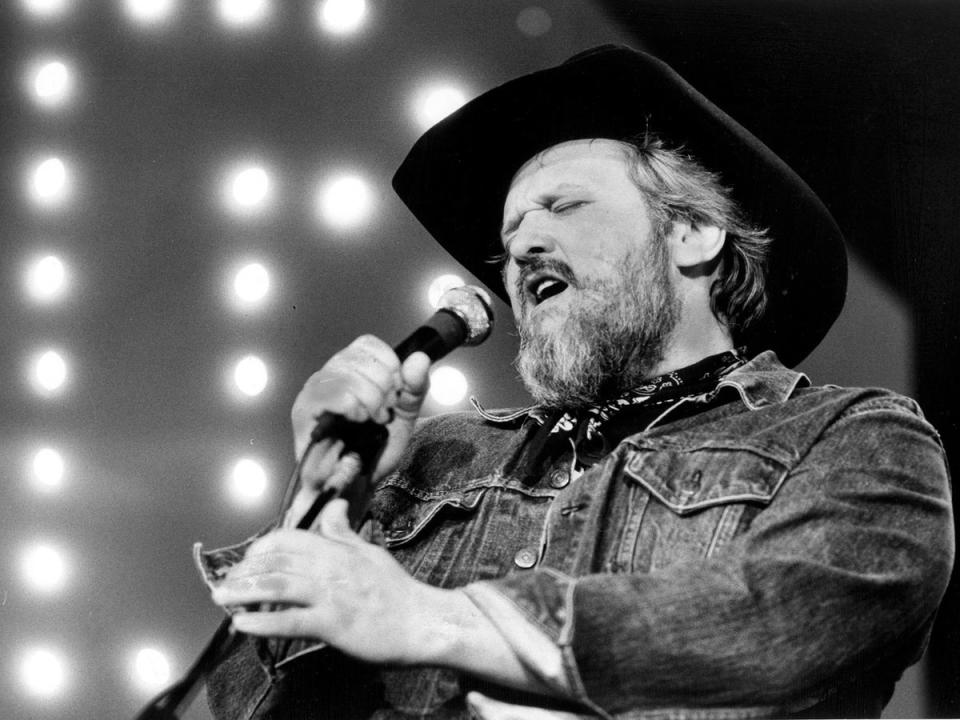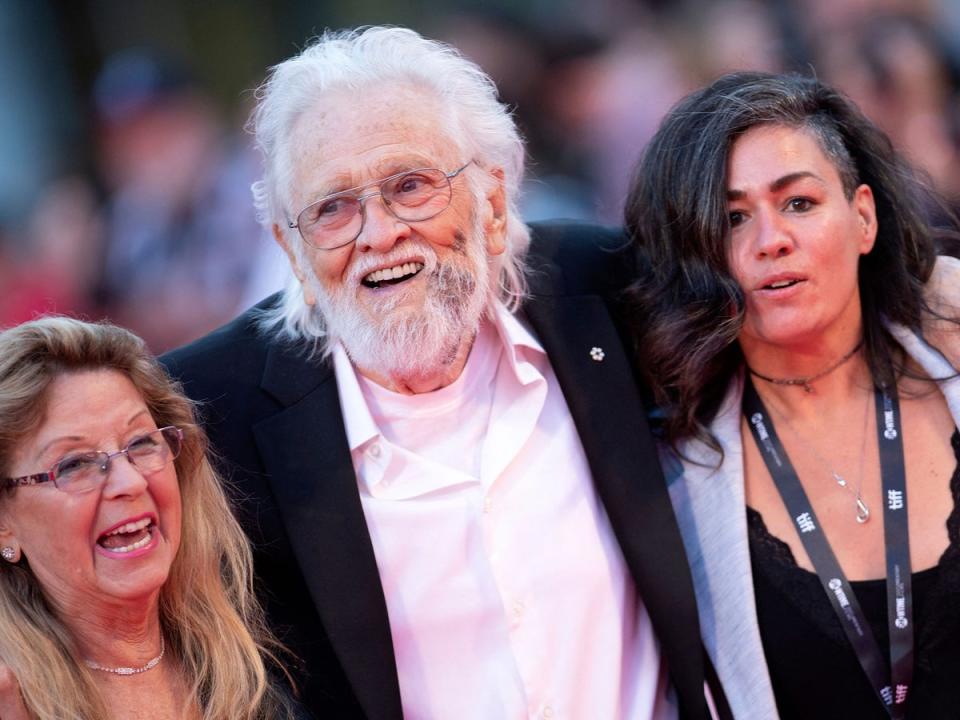Ronnie Hawkins: One of rock’n’roll’s greatest showmen

Although Ronnie Hawkins never had much success on record, he was one of rock’n’roll’s greatest showmen and certainly its wittiest advocate. “Ninety per cent of what I made went on women, whiskey, drugs and cars,” he once told me, “I guess I just wasted the rest.”
Ronnie Hawkins was born in Huntsville, Arkansas, on 10 January 1935, although he was raised in Fayetteville. His father, Jasper, was a barber and his mother, Flora, a teacher. “My dad was a champion redneck, liked to drink, chase women, fight and do all those things that rednecks like. My mother was the complete opposite – she was a religious fanatic who never missed church in 40 years and used to give 10 per cent of all she earned to the church, which really p****d my dad off.”
His uncle Delmar was a fiddle player who encouraged Ronnie to sing. Delmar’s son, Dale Hawkins, also a performer, wrote and recorded the classic song, “Susie-Q”. Although Dale and Ronnie did not see much of each other, they shared an interest in the blues.
From 1952, Ronnie Hawkins went to Memphis to buy records: “Before Elvis hit it big, a bunch of us – and Jerry Lee Lewis was among them – used to meet on Beale Street. We told him that he wouldn’t go anywhere with a name like Elvis Presley: he’d have to change it. In 1954, Elvis couldn’t even spell Memphis: in 1957, he owned it.” After Elvis was signed by Sun Records, Ronnie Hawkins auditioned for the label, but he was passed over.
Hawkins attended Arkansas University, obtaining both science and PE degrees, but his heart was in the “chitlin’ starvation circuit” playing music. Because the pay was poor, musicians went from one club to another using the “Arkansas credit card” – a siphon, a rubber hose and a five-gallon can.
After moving to West Helena, Arkansas, Hawkins formed an argumentative band, The Hawks, with Levon Helm on drums. He changed personnel in a search for what he wanted, saying: “No matter how good a singer you are, you’re only as good as the band that backs you.”
He described those days with affection: “The older people didn’t like the music at all and when someone down south says it’s the music of the devil, that’s all it takes to mushroom into something big. The churches would come down on us and the high schools would be forced to cancel engagements. The high-class places wouldn’t have rock’n’roll and we would end up playing the bars with the chicken wire up front. That was mandatory because the drunks would be getting wild and throwing bottles at the stage.
“It was part of the lifestyle of those B-joints, some of which were owned by Jack Ruby, who also had go-girls and strippers. You’re supposed to be 21 before you can go into a bar, and as most of us were younger, we ended up on the outlaw club circuit which was really rough. We were two grades below being a prisoner of war. We existed without any other means of financial support, although we had to supplement our income to get a guitar out of hock or something like that. One summer I painted the [riverboat] Memphis Queen when things were pretty rough.”

In 1958 his friend, Harold Jenkins, later Conway Twitty, had found some success in Hamilton, Ontario, and invited Hawkins to join him. Hawkins did well at the Golden Rail in Hamilton and made his first record in Toronto.
Morris Levy in New York heard of his reputation and signed him to his label, Roulette Records. Released in 1959, “Forty Days” went to No 45 on the US charts and No 9 in Canada. It was an amended version of Chuck Berry’s “Thirty Days”: “Chuck Berry had simply put new lyrics to ‘When The Saints Go Marching In’. My record company told me to add 10 days. They knew Chess Records wouldn’t sue as they wouldn’t want to admit it was ‘The Saints’.”
Hawkins found that his records fared best in Canada, scoring Top 10 hits with “Mary Lou” and “Southern Love”. With his handstands and leapfrogging, he became known as Mr Dynamo and he pioneered a dance called the Camel Walk.
In total contrast, he became, in 1960, the first rock’n’roller to involve himself in politics with a plea for a convict on Death Row, in his song “The Ballad Of Caryl Chessman”, but to no avail. “And who’d buy the record after the guy had been gassed?” said Hawkins. He widened his repertoire with the albums, Ronnie Hawkins Sings The Songs Of Hank Williams (1960) and The Folk Ballads Of Ronnie Hawkins (1961).
For a time, Hawkins was managed by Norm Riley who also handled Eddie Cochran and Gene Vincent: “Eddie was a real nice cat, took care of business, looked good and had a lot of common sense. Gene was a little wild, a heavy boozer who did lots of crazy things. Their money, like mine, was being handled by Norm Riley. Later on, he got himself checked into a mental institution and said he couldn’t remember where the money was. We never got our money so he got away with it.”
In 1960 Riley arranged for Hawkins and Helm to travel to the UK for the ITV show Boy Meets Girls. Hawkins was so impressed by Joe Brown’s guitar playing that he offered him a job, although he did not accept it.
The Hawks’ personnel transmogrified into Levon Helm, Robbie Robertson, Garth Hudson, Richard Manuel and Rick Danko. The Hawks wanted to move on from rock’n’roll and, in 1963, they recorded a remarkable single with Hawkins of “Bo Diddley” and “Who Do You Love”, which was psychedelia long before its time.

His band recorded as Levon and the Hawks and then backed the blues singer, John Hammond. Hammond recommended them to Bob Dylan, who took them on a world tour in 1966. Dylan had a long, working relationship with the musicians, who also made several albums as The Band. Hawkins was reunited with them for the 1976 concert The Last Waltz, which was filmed by Martin Scorsese.
During the instrumental break in “Who Do You Love”, Hawkins fans Robertson’s guitar with his hat. Hawkins played “Bob Dylan” in Dylan’s puzzling film, Renaldo And Clara, also in 1976: “I was in his Rolling Thunder Revue and he woke me about four in the morning and said he wanted to film. He said, ‘You’re me and you’re trying to talk this girl into running off with you.’ That was all the direction he gave me.”
Hawkins settled in Canada in 1962 when he married a former Miss Toronto, Wanda Nagurski. They had two sons, Ronnie Jr (born 1963) and Robin (1964), and a daughter, Leah (1969). Hawkins supported local talent and refused to work in clubs that did not give equal bookings to Canadian artists.
He had a long residency at the Le Coq D’Or in Toronto. He kept forming new line-ups and one constant feature was the excellent pianist, Stan Szelest. Duane Allman (guitar) and King Biscuit Boy (harmonica) play on his Atlantic album Ronnie Hawkins (1970), which led to a Canadian hit, “Home From The Forest”, written by Gordon Lightfoot. His experience in buying a Rolls-Royce with cash was recounted in Gordon Lightfoot’s “Talkin’ Silver Cloud Blues”.
In 1969 John Lennon and Yoko Ono stayed at Hawkins’s home when they appeared at the Toronto Peace Festival and Lennon recorded a promotional introduction for Hawkins’s single, “Down In The Alley”. The cost of the publicity was high as the Lennons ran up a huge telephone bill, flooded the bathroom and burnt down the garage. Undeterred, Hawkins had Dr John as a house guest and his marijuana intake meant that the whole house had to be redecorated.
In 1972 Hawkins made the album, Rock And Roll Resurrection, and Kris Kristofferson’s sleeve notes give an insight into Hawkins’s character: “He wears all his faces well, combining backwoods cunning with a simple honesty not to be found north of the Mason-Dixon line. A legend’s usually bigger than life, but he lives up to it with more purpose, intensity and obvious pleasure than your run-of-the-mill hero. The energy flows into his music.”
Hawkins’s many albums include The Giant Of Rock’n’Roll (1972), The Hawk (1979), A Legend In His Spare Time (1981), Making It Again (1984) and Hello Again Mary Lou (1991).
In 1985 Hawkins joined Joni Mitchell, Anne Murray and Neil Young to record “Tears Are Not Enough” to raise money for Ethiopia. He had a successful TV series in Canada, Honky Tonk, and his 60th birthday was celebrated with a televised concert featuring Jerry Lee Lewis, Carl Perkins and The Band. His authorised biography, The Hawk, by Ian Wallis, was published in 1996. He was honoured by President Clinton and given a Juno Lifetime Achievement Award, Canada’s equivalent of the Grammys.
He is survived by his wife of 60 years, Wanda, and their three children.
Ronnie Hawkins, musician, born 10 January 1935, died 29 May 2022

 Yahoo News
Yahoo News 